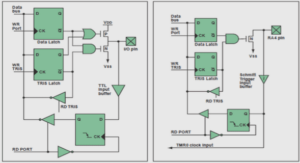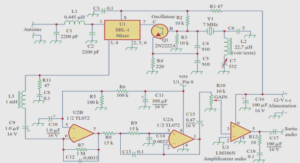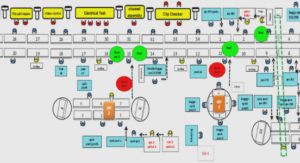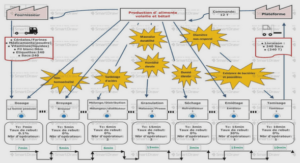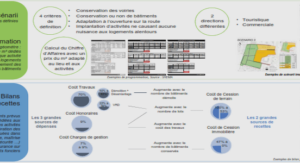Modeling & Analysis
Overview The gain scheduling methods of Chapter 1 that were judged to be the more promising and also offering the best background for further development were tested using two different benchmark examples. The first one is an analytic nonlinear model of the pitch axis dynamics of a highly manoeuvrable missile called the Reichert Missile Benchmark (R’m’B). The second one is a tabulated nonlinear example of an atmospheric reentry vehicle (ARV) provided by the EADS Astrium Space Transportation corporation. This chapter gives the results obtained from the application of the first two steps of the Linearizationbased Gain Scheduling Procedure (LBGS) of Section 1.3.1 (trimming and linearization) on these systems. Given that these two steps are common for any candidate for gain scheduling nonlinear system, the same analysis techniques were used and the results are presented in a similar way.
The Reichert Benchmark Missile Model
The Reichert Missile Benchmark (R’m’B) was first presented in the control literature in the early 90’s (see [112]) and has been the benchmark system for many works since, mostly due to the fact that it incorporates analytic formulas for the aerodynamic functions of the system. In this monograph, a similar but more recent version of the model appearing in [103] will be preferred.
Airframe Modeling
The nonlinear model of the R’m’B describes the longitudinal (or pitch) dynamics System of a highly manoeuvrable missile airframe around its center of mass. The state dynamics vector x of the missile (see Fig. 4.1)1 is its angle of attack α (in rad) and pitch rotational rate q (in rad·s −1 ). The command is the elevator deflection angle δ (in rad), the output is the vertical acceleration η (in g’s) and its Mach number M is considered as an internal time varying parameter.The missile is considered to be operating during the terminal target inter- Mach trajectory cepting phase with its engine thrust equal to zero and the Mach profile given by the following nonlinear differential equation: dM dt = 1 vs ¡ −|η|sin|α| + AxM2 cos α ¢ , with M(0) = M0. (4.10) The elevator fin is driven by an actuator modeled using the following second Actuator order filter ( dynamics δc (in rad) is the control signal provided by the autopilot): d 2 δ dt + 2ξωa dδ dt + ω 2 a δ = ω 2 a δc. (4.11) The actuator and missile data coefficients are shown in Table 4.1. It should be noted that the latter are generally dependent on the flight altitude that is here considered as constant. The nonlinear mathematical model of the missile is valid for −20◦ ≤ α ≤ 20◦ and for 1.5 ≤ M ≤ 3; these two variables forming its flight envelope. The aerodynamic functions related to the angle of attack Cnα,Cmα for α > 0 3 are shown in Figs. 4.2a, 4.2b. It can be observed that there exists a significant variation of the functions values over α and M.
Trim Analysis
In this section the application of the first step of the Linearization-based Gain Scheduling Procedure (LBGS), concerning the missile trim control computation, will be detailed. The trim control δr is the rudder reference deflection angle needed in order to stabilize the missile around an equilibrium (or reference) point in the absence of external perturbations. The equilibrium points can be parameterized as function of the angle of attack α or the vertical acceleration η, and the Mach number M. Each pair, α, M or η,M, forms the so-called scheduling vector ̺ used to describe the flight envelope of the missile. 4.1.2.1 Parametrization on α The trim control δ(̺r) = δr for each value of the scheduling vector ̺r = [αr Mr] T Trim input inside the flight envelope specifications (−20◦ ≤ αr ≤ 20◦ and 1.5 ≤ Mr ≤ 3) can be calculated easily using Eqs. 4.2, 4.5, 4.7 and 4.9. Given that the airframe is on equilibrium for a given value ̺r, then dq dt ¯ ¯ r = 04 and so: δ(̺r) = − Cmα(̺r) Cmδ αr.
Flight Envelope Analysis
Most works concerning the R’m’B model lack a thorough analysis of the missile’s flight envelope (see [17, 36, 55, 81, 99]). This is probably due to the fact that the flight envelope is directly parameterized using α,M and not η, M that is more realistic, since α is not available for feedback8 . However, all the oper- [α, M] flight envelope ating constraints are initially imposed on the angle of attack and the Mach, as presented in Section 4.1.1, defining the corresponding [α, M]-dependent flight envelope Γ [α,M] fe : Γ [α,M] fe : £ |α| ≤ 20◦ , 1.5 ≤ M ≤ 3 ¤ . (4.21) The flight envelope can be re-parameterized in terms of η, M, using the analysis of Section 4.1.2. The result is a non convex hull as it can be seen in Fig. 4.4b (for ηr > 0), with the isoline α = −20◦ setting the right border of the envelope. An analytic expression ηfe(M) for this isoline can be easily found by setting α = −20◦ in Eq. 4.17 (symmetric results are obtained for for ηr < 0): ηfe(M) ≃ −0.454M3 + 5.035M2 .The discussion of this section showed that if a careful analysis of the operating domain is not performed according to the initial nonlinear system constraints, redundancy will occur. Indeed, if a rectangular flight envelope had been used as in Section 4.1.2, the surface redundancy with respect to Γ [η,M] fe would have been around 60%, whereas with the linear approximation Γ [η,M] fe,lin it is only 3.6%. This surface redundancy is particularly important for a gain-scheduled controller since it can significantly augment the number of synthesis points and hence the interpolation complexity.
System Linearization
After the analysis of Sections 4.1.2.1-4.1.2.3 and the parametrization of the equilibrium points of the missile in terms of the scheduling vector ̺ = [η M] T , the second step of the Linearization-based Gain Scheduling procedure (LBGS) concerning linearization will now be detailed according to the standard analysis of Section 1.3.1..

